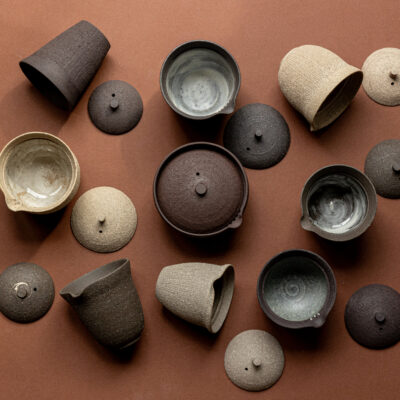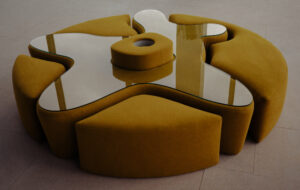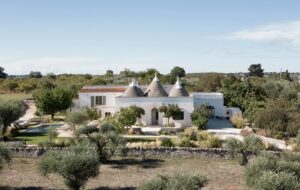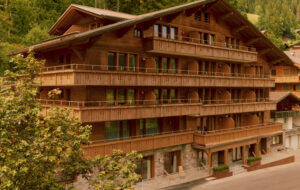|
|
||
|
In a huge, sweltering factory on Murano, an island just north of Venice, two glass masters sit on metal benches as muscular assistants work busily around them. These apprentices use furnaces to heat up globs of glass on the ends of long, hollow metal rods, rolling the incandescent, treacly paste in plates of iron filings and crystals to add texture and colour, before presenting them to the maestros. With an economy of movement, and only a very few tools – pincers, scissors and a metal spatula – the glass masters blow and dexterously manipulate the hot glass. “Everything is as it was in the middle ages,” explains studio owner Adriano Berengo, who is dressed flamboyantly in a pink scarf and red-framed dark glasses. “The only thing that’s changed is that they used coal, we use gas.” The two furnaces burn 24 hours a day; smaller kilns are used to cool the finished pieces, which would shatter unless the temperature in them weren’t made to drop slowly. “Even so, 20 percent break,” Berengo sighs. As the glass masters work, off-cuts fall to the floor in strings of gloopy, multi-coloured mess. They curl and crack as they cool, splintering and exploding at our feet. “Glass is something that doesn’t allow you any rethinking,” says Berengo. “With glass, when you start you have to finish. You have to act when it is hot.” For the past 20 years, Berengo has been trying to raise the profile of glassmaking, freeing it from “the exclusively commercial ghetto in which it has been imprisoned for years”. He hopes to restore the grandeur that Venetian glass, now associated with tourist kitsch, once had by inviting artists, architects and designers to come to Murano to realise their designs in his factory – more than 150 have taken up his invitation so far. Alongside the 2009 Venice Biennale, Berengo organised Glasstress, an exhibition of contemporary glasswork in Palazzo Cavalli-Franchetti on the Grand Canal and a cavernous former glass factory he owns in Murano, where he dreams of creating a permanent museum for contemporary glass. At Glasstress 2011 (4 June – 27 November), Zaha Hadid, Tony Cragg, Kiki & Joost, Atelier van Lieshout, Zhang Huan, Vic Muniz and Tokujin Yoshioka will all show work. Berengo’s project continues the tradition of his hero Egidio Constantini (1912-2007), who in the 1950s and 1960s sought to restore art to the craft by commissioning designs for glass sculptures from Picasso, Jean Arp, Max Ernst, Jean Cocteau, Alexander Calder, Le Corbusier, Chagall and Kokoshka. Cocteau named the studio Constantini founded, and which inspired a new wave of experimentation in the medium, La Fucina degli Angelli (The Forge of Angels). But by the late 50s, the enterprise foundered for lack of funds and Constantini appealed to the imperious American art collector Peggy Guggenheim for assistance.
credit Francesco Allegretto “In 1961 I had a visit from a man called Egidio Constantini,” Guggenheim wrote in her memoir, “who sought my help to execute glass sculptures from the many designs he had from all the most famous artists. He had no money to produce the glass and was quite desperate. He even wept. As I cannot bear to see a man cry, I promised to help him.” Berengo acknowledges: “I only had the courage and perhaps the recklessness to continue along the path forged by Constantini.” Glassmaking, Berengo continues, as a man wanders past us holding a maquette of a huge dinosaur bone (part of a project by Chinese artist Shi Yong), “is an alchemical process”. He and his master glass blower, Danilo Zanella must educate their collaborators in the constraints of the medium to help them to realise their visions. “Certain artists start with enthusiasm and then drop off,” Berengo admits. “They imagine it like Plexiglas. They get a big surprise when they deal with this material – by the ingenuity and skill of the glass master and the potential of what you can do if you understand the medium.” “You really learn by going there and working with the glass blower,” says Kiki van Eijk, who is showing her surreal assemblies alongside work by her design partner Joost van Bleiswijk at Berengo’s commercial space, Venice Projects. “It’s such a special material. It forces you to think in a different way. There’s still something magical about it because on one hand it’s so fragile and on the other you can create vivid colours that are almost impossible in any other medium, even paint. The material has a kind of poetry within itself.” When she first visited Berengo’s studio van Eijk was told that her ideas weren’t technically possible, that they were too difficult to realise. “Artists and designers always want to go beyond the boundaries and do something that hasn’t been done before,” she explains. “If you go there and discuss your ideas with them, slowly you understand the material a little better, but because I came from a non-glass world I was able to marry that knowledge with other influences. Naivety is positive because you can still think very broadly and adapt it to what is possible. And the craftsmen are pushed beyond their own expectations and surprise themselves.” The day I visit Murano, Dutch designer and fledgling glass artist Ted Noten is presenting his initial ideas to Berengo, who had seen crystal possibility in Noten’s Back-up (2007), a handgun suspended in an acrylic bag. For Glasstress, Noten proposes casting a toy pistol in glass and sending these models to local craftsmen, who would be invited to customise them as they wish by adding, for example, ornate engraving, diamonds or a golden trigger. Noten plans to show each one in a glass suitcase and hopes that collectively they will make up a “library of dying, traditional techniques”. But he has other ideas he wants to run past Mr Berengo: a black glass gun with a €20,000 diamond secreted within it. “So you have to break the gun to see the diamond?” Berengo asks, unimpressed (Noten suggests each gun be sold with an X-ray and certificate of authenticity). He then proposes an even more extravagant project: a huge barge in the shape of a gun that would float in the lagoon off the Arsenale where it would be filled with all the champagne and prosecco bottles drunk at the Biennale. Noten would recycle these into hundreds of green glass guns that visitors could buy and attempt to smuggle home in their suitcases. In collaboration with Constantini, the French artist César, famous in the 60s for his “Compression” sculptures made with the help of a crushing machine, created glass sculpture out of recycled bottles. In 1992 he melted and squeezed coke bottles into glass bricks, rubbish to be thrown away, as if to mock Andy Warhol’s uncritical celebration of pop. For Glasstress 2009, Tony Cragg created a teetering mountain of identical glass vases, bound together with dynamic swirls of glass string, which seemed to refer back to César. But Noten’s project takes things to a new scale. “They’d never give you permission,” Berengo laughs, “it’s not easy … it’s a dream”. Unperturbed, Noten presents another idea, a 3m wide snow globe with a robotic arm inside that would etch the glass with a picture of Vitruvian man. “Nobody could blow a sphere that big,” Berengo protests, throwing up his hands. “The size of the piece can’t be larger than the opening of the glass maestro’s arms, or bigger than the mouth of the furnace! I’m following the dream up to a certain point, but then we have to crash with reality.” Sheepishly, Noten presents a final idea. “I hesitate to show this, because I still don’t accept that my other ideas aren’t possible – and I know that this is possible.” He puts on a small ring that supports a tiny glass and pours an envelope of pearls, rubies and diamonds into the open receptacle. The piece is called You Have to Suffer to be Beautiful, because if the wearer tilts their hand they risk losing this precious cargo. Needless to say, it is eventually decided that at Glasstress Noten will show an enlarged metre-high version of this piece – with enormous cut-glass diamonds, red rubies and blown-glass pearls – alongside his glass guns. Berengo’s office is crammed with realised work destined for the exhibition. Vic Muniz has created an enormous hourglass with a brick wedged in the top of it instead of sand. Luke Jerram has created a series of glass viruses, blown-up to reveal their poisonous, spiky forms. However, at the time of going to press much of the work is still to be created. Zhang Huan will show a huge 6.5m long turtle shell in ultramarine glass, under which the creature’s body will be moulded in his signature ash. Zaha Hadid will make a parametric chandelier. Jaime Hayón is experimenting with a glass phrenological head, through which will be seen a cartoonish anatomy. Tokujin Yoshioka wants to build a small teahouse with a roof entirely tiled in glass. And Atelier van Lieshout, known for CasAnus (2007), its house modelled on the human digestive system, is creating a black glass “excrematorium”, a Henry Moore-like vessel with six holes, one designed for each bodily excretion. Out of the 45 artists whose work will be exhibited at Glasstress, Berengo says that 40 percent are architects and designers, but hardly any have previously worked in glass. One of those that has is Pieke Bergmans (Icon 069) who, Berengo says with admiration, “has explored the medium extensively”. Bergmans creates Crystal Viruses by having glass masters blow large vessels, and drop them on to chairs and other items of furniture that she has found (manufacturer Vitra also donated some of its own products for infection). “I design the process,” she has explained. “The process actually designs the piece.” The molten glass sets fire to and scars the wood and slumps around the seat to create beautiful laval shapes wholly dictated by chance.
credit Mel Bles |
Image Eric Flogny
Words Christopher Turner |
|
|
||















